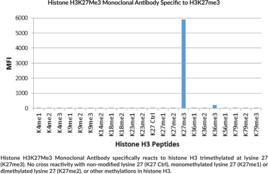Description
Histone H3 is a nuclear protein and a component of the nucleosome core, a basic unit of chromatin, that is essential for organizing genomic DNA in eukaryotic nuclei.{57056} It is a globular protein that contains an unstructured N-terminal tail that extends outside of the nucleosome core and is subject to various post-translational modifications (PTMs), including methylation, phosphorylation, acetylation, and citrullination.{57056,53978} Trimethylation of histone H3 at lysine 27 (H3K27Me3) is associated with gene silencing.{42743} It is involved in tumor progression through its regulation by enhancer of zeste homolog 2 (EZH2) and transcriptional repression of tumor suppressor genes.{49135,49132} Levels of H3K27Me3 are reduced in 293 T-REx cells containing EEDR236T and SUZ12G610V mutations and in lymphoblastoid cells isolated from patients with Weaver syndrome, a rare overgrowth disorder characterized by EZH2, EED, or SUZ12 mutations, cancer susceptibility, and various distinctive physical features.{49133} Cayman’s Histone H3K27Me3 Monoclonal Antibody can be used for chromatin immunoprecipitation (ChIP), ELISA, immunohistochemistry (IHC), multiplex-based assay, and Western blot (WB) applications.
Synonyms: Trimethylated Histone H3 Lysine 27
Immunogen: Peptide corresponding to H3K27Me3
Formulation: 100 μg of protein A-affinity purified monoclonal antibody
Isotype: IgG
Applications: ChIP, ELISA, IHC, multiplex-based assays, WB
Origin:
Stability: 365 days
Application|ELISA||Application|Immunohistochemistry||Application|Immunoprecipitation||Application|Multiplex||Application|Western Blot||Product Type|Antibodies|Monoclonal Antibodies||Research Area|Epigenetics, Transcription, & Translation|Erasers|Histone Demethylation||Research Area|Epigenetics, Transcription, & Translation|Histones/Histone Peptides|Methylated||Research Area|Epigenetics, Transcription, & Translation|Writers|Histone Methylation




